Board Game Breakdown: Catan Part 3: Build Timing
- Alex Cates
- Feb 5, 2022
- 6 min read
Updated: Sep 4, 2022
In Part 1 and 2 we looked at an average Catan game and quantified the value of the 5 resources. And while resources are the engine that powers the game of Catan, building is what you actually do. After all, the winner is the player who has built the most victory points, not the person who received the most resources. Therefore the what, when, and where of building are how you impart your strategy and flair on the game. Should you try to build a settlement or city first? How many dev cards should you build? And is there a tipping point where building now helps you build more in the future (my friends like to say that "cities make cities" but is that actually true?) In today's post, we will explore these questions to try to better understand the impact on building.
The Data
As before, we will be using turn by turn data collected from colonist.io. As I've previously stated, this is largely data collected by myself, though it has been augmented by other players recently. Note if you would like to contribute to the dataset, you can do so at colonist_data (anvil.app). It really helps. And I plan to build out the web app in the coming months to provide more detailed statistics about your game.
Just to drive the point home, the biggest limitation with my collection process is that I do not know what the board looks like (as in where resources are relative to different settlements). That being said, we can still make some broad claims about the impact of building that I think are interesting.
Is Building More Always Better?
Catan rewards building things, whether with increased resources (as in cities and settlements), more opportunities (roads), or special abilities (development cards). But is it always better to build more? Or are there decreasing returns on our investments?
Scatterplots with linear regression of the odds of winning the game based on the total number of roads, settlements, cities, or development cards built by a player in a game. The red line represents the base random odds in a 4 player game
As we can see from the graphs above, if the constructions are guaranteed point generators (i.e. settlements and cities) then yes, more is better. This should be obvious since the goal is to earn victory points, but it bears mentioning. In fact, we can see that you are expected to build at least 2 settlements and 2 cities in a game, any less than that, and your odds of winning drop below chance levels.
However, non-point generating constructions, such as roads and development cards, have different relationships.
Roads are pretty random, but there is a general trend that having more roads is better, though the relationship is really weak. This aligns with the role roads play, opening opportunities for points (through more settlements), but not generating points on their own and therefore you should rarely build roads for the sake of it and instead build roads with the purpose of building more settlements.
Development cards are the most interesting as there appears to be a step function going on. You don't want to go the whole game without buying any development cards (as any less than 3 dev cards lower your odds of winning), but at the same time, there is not much difference between buying 4 and 8 development cards (at least in terms of your odds of winning). There is value in going over 8 development cards, but I would imagine if you are buying 9 or more development cards, then that was a plan from the beginning and you are generating massive amounts of ore, wheat, and sheep.
But what should you build first?
We have established a focus on settlements and cities, but which is better? Specifically, which should you prioritize at the beginning? An early settlement may be key for securing a port or for diversifying your resources and resource numbers enough to be successful. In contrast, an early city may secure a larger volume of resources for the entirety of the game. So which is better early?
Scatter plots with linear regression of the odds of winning the game based on when a player builds their first settlement or city. The red line represents the base odds of a 4 person game (25%).
First, for both settlements and cities, we can see that the earlier you build your first one, the better. This is not surprising given that Catan is a game that builds on itself and for the most part, the rich get richer (something we will see more later on). Interestingly, the relationship is actually stronger for settlements than cities. Part of this may be that settlements are cheaper and easier to build early, but there is a clear estimate here that if you have not bought a settlement by turn 35 (the 35th roll) you are in serious trouble (no surprise).
The city curve is more forgiving, with basically even to positive odds as long as you eventually do build a city, as we saw with the first post in this series, cities are extremely important for eventually winning and we can see that if you don't ever build one your basically doomed.
So which should you build first?

Point plot with 95% confidence interval of your odds of winning with a settlement or city first
When we compare the win rates of players who built a settlement first vs those who built a city first, we actually see that building a settlement first is better. In fact, players who built their first city before building their first settlement actually faired worse than the base random odds. It should be noted that these are raw numbers so it may be that the city first odds are dragged down by being built later, I am not sure. But it seems to tell a similar story to the previous graphs of when to build your first settlement. Overall, I think you should try to build another settlement before a city, probably to help secure resources, numbers, or ports, but this can obviously change depending on the game.
The Cumulative Impact of Building aka Cities Make Cities
As a final question, lets explore the cumulative impact of building. Does building one lead to building more? And does the eventual winner hit milestones differently than the losers?
Line plots of the number of Roads or Development Cards a player has at a given turn, split by whether they ended up winning or losing the game.
As we saw with the totals, there is not much separation in terms of the winning and losing players based on the number of roads or development cards built on any given turn. There may be a little separation in terms of development cards at the end, likely driven by players searching for the last victory point or knight to earn the largest army, but overall I don't think these are what drive winning or losing.

Line plot of the number of Settlements a player has at a given point in the game, split by whether that player ended up winning or losing.
When we focus on the settlements and cities, we can see some clear separation. First, settlements do get more settlements, with the winning player building settlements faster than the losing players throughout the game. It's actually shockingly linear, such that the winning player simply builds settlements 36% faster than losing players (winner slope = .045 settlements per game turn vs loser slope = .033 settlements per game turn on average). Remember that a game turn is any player's turn, such that you can build once every 4 game turns. However, that is nothing compared to what happens with cities.

Line plot of the number of cities a player has built at a given point in the game, split by whether a player won or lost.
Here we see exponential growth. Meaning that the winning player builds cities faster than losing players and that each successive city speeds up this build rate. In other words, cities do make cities. The exponential nature of city-building also helps explain their importance towards winning, as there is the potential for cities to snowball, ensuring a player's win.
Limitations
As mentioned above, the biggest limitation is that we do not have a sense of what the board looks like. Some boards are more conducive to cities while others promote settlements, and this analysis only looks at general trends across all boards. Additionally, as before, I am including games played by bots in this dataset, I am doing this to maintain a large sample size, though I will mention that the general trends of the results remain unchanged if I look at the smaller sample size of non-bot games.
Conclusions
There are a few takeaways from this analysis and while I don't think any are earth shattering, its interesting to see such clear results from the data. First, you should prioritize building a settlement early. Second, once you have the 3rd settlement (your 2 starting settlements plus the third settlement you just built), you should focus on building cities and expanding your resource engine. Third, roads and development cards are useful, but only as a means to produce more cities and settlements.
Questions? Comments? Let me know at ac@alexcates.com. Want to read more breakdowns like this? sign up for my newsletter here. Finally, like what I do? Consider supporting me on buy me a coffee.


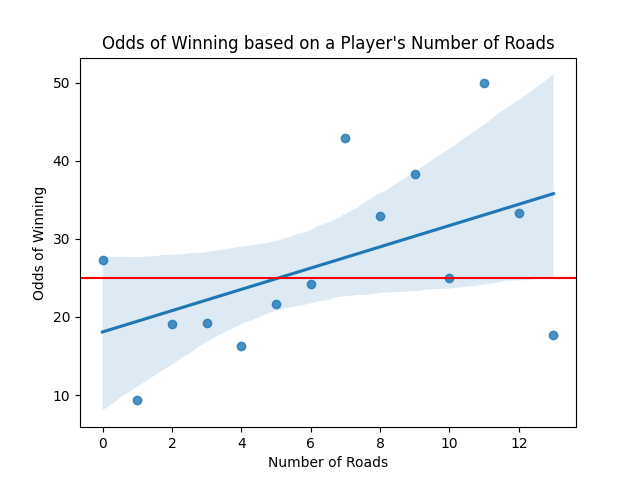

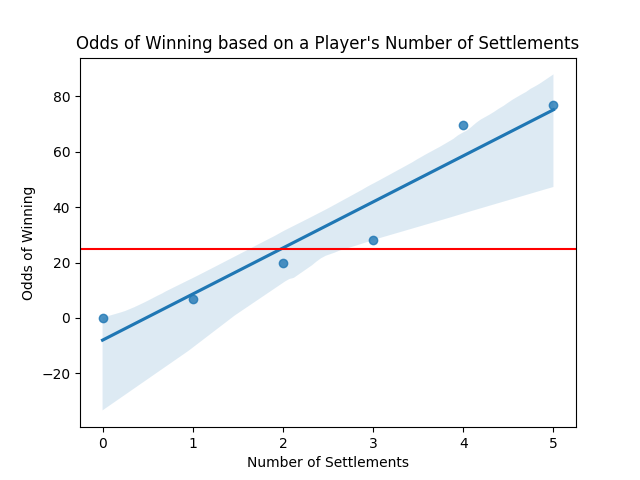

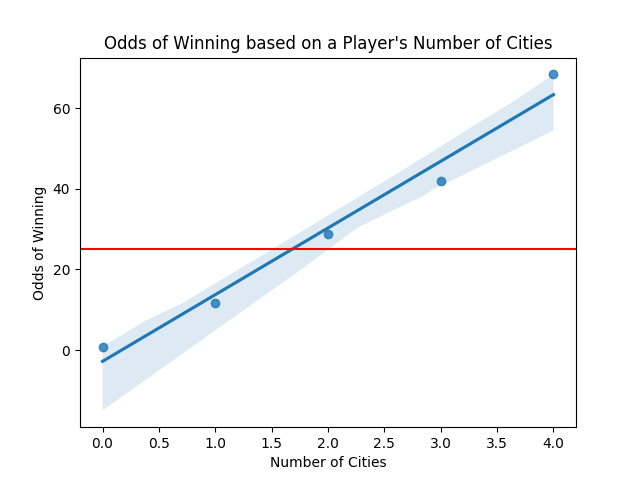

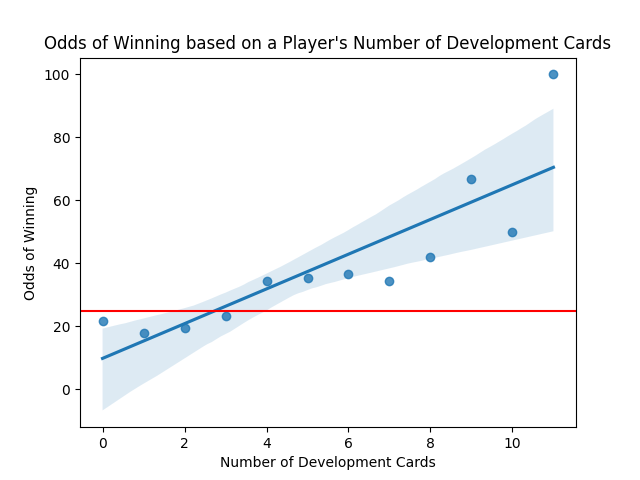

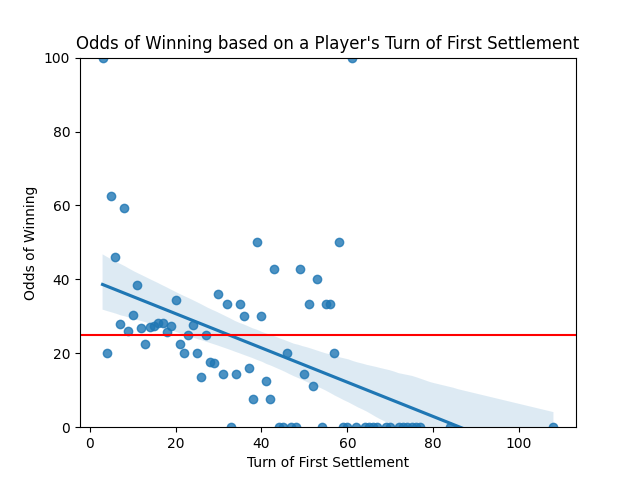

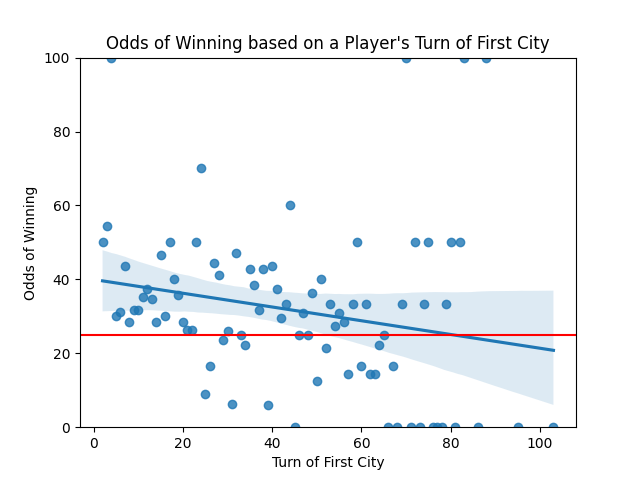

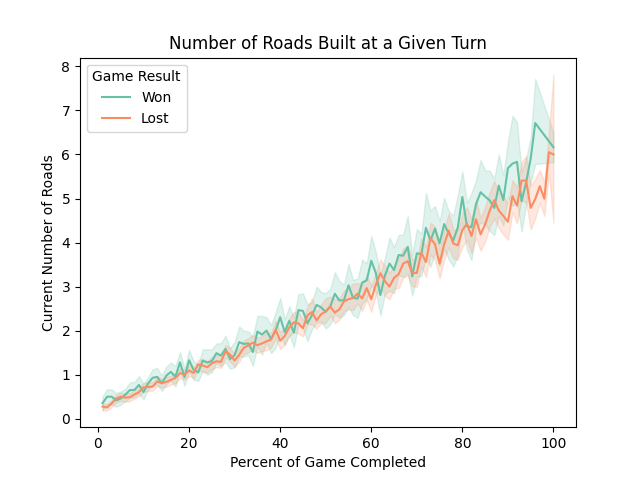

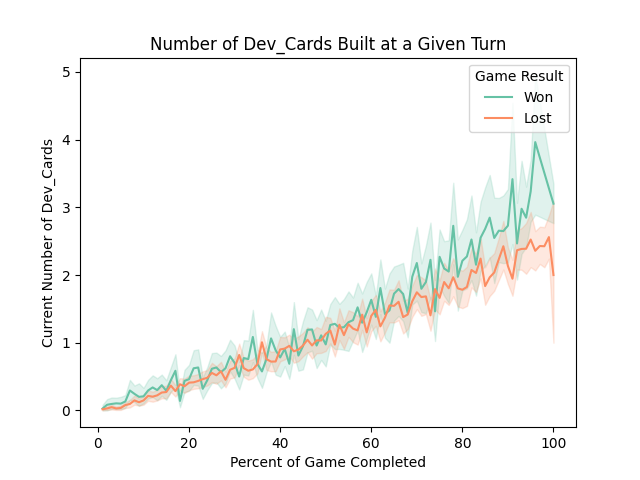
Comentarios